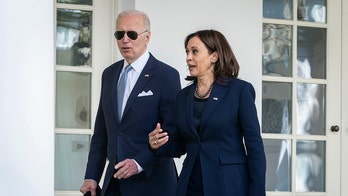The family members of Dwight D. Eisenhower are upset over a memorial for the late president that prominently features a small monument showing "Ike" as a child and barefoot rather than giving greater attention to the war hero and world leader he became.
"President Eisenhower's contribution to this nation is not the central theme to this design," Susan Eisenhower, the president's granddaughter, testified Tuesday to the House Natural Resources Subcommittee on National Parks, Forests and Public Lands.
She and other family members object to the design by the highly awarded architect Frank Gehry, who designed the Guggenheim Museum in Bilbao, Spain.
Susan Eisenhower said the design of the roughly 80-foot-tall statue, which would go on the National Mall, instead has a "Horatio Alger" narrative that portrays the late president as a "dreamy boy."
According to the design plan, the estimated $100 million memorial park, framed by large metal tapestries depicting Eisenhower's boyhood home in Kansas, is a triptych containing one statue of a young Eisenhower marveling at two later bas-relief versions of himself.
The family has said it finds the main theme of the memorial offensive to Eisenhower's legacy as a two-term president and a Supreme Allied commander during World War II.
In a January 2012 letter to the National Capital Planning Commission, the family wrote that the childhood image risks "isolating Ike from contemporary visitors, especially those from urban industrialized parts of the country and immigrant communities. Eisenhower has as much to say to these Americans as he does to farm children from the Midwest. During the war, Eisenhower liberated not only Europe, but also the victims of the Nazi Holocaust. During his presidency, he successfully desegregated the Armed Forces of the United States and the nation's capital, Washington, D.C., to name only two of his civil rights accomplishments."
Although the memorial design was unveiled a year ago, the opposition to it grew louder this winter after grandson David Eisenhower resigned from the Eisenhower Memorial Commission, which selected Gehry for the design in March 2010.
The National Civic Art Society, which has set up an alternative website to the memorial group's website, outlines its opposition in direct terms. It calls the "tapestry" a "rat's nest of tangled steel, a true maintenance nightmare."
Eisenhower said the tapestry would collect trash and suggested the design concept is part of the "communist world" of art, adding her grandfather likely "wouldn't understand it."
Justin Shubow, president of the group and an attorney who litigates cases alleging fraud by the federal government, issued a 154-page report on Sunday saying the memorial's "core of kitsch" is the solitary statue of Eisenhower depicting him "as a life-size barefoot young boy, a shrinky-dink tikey Ikey."
"This Happy McMonument does not befit a statesman who defeated the Nazis and who preserved America's peace and prosperity. Leadership is not child's play," reads the report.
The report adds that the memorial design contains benches spelling out "IXXI," the Roman numerals for 9 and 11, which the group says whether intentional or negligent should disqualify Gehry.
Shubow's group is demanding that a new competition to commission the memorial, saying the original one that selected Gehry was "secretive, exclusive, elitist and undemocratic" because it only allowed 44 entries, rather than hundreds that other memorial competitions get.
But the memorial commission says the architectural design is a testament to all Eisenhower valued.
"This imagery represents not only Eisenhower's humble beginnings, but also speaks to the values he carried with him throughout his life. As Eisenhower did, the tapestry brings a bit of the heartland to our nation's capital. The story of Eisenhower runs as a parallel to the story of America in that time -- a young, isolated country making a rapid ascension on the world stage. Eisenhower, like America, rose to the occasion with courage and integrity," reads part of the memorial commission's description of the design.
But opposition to the memorial, which was approved by the Department of Education that sits behind the proposed site, is growing. Rep. Frank Wolf, R-Va., Dan Lungren, R- Calif., and Aaron Schock, R-Ill., all petitioned the National Capital Planning Commission asking for a delay in approving the memorial.
Rep. Darrell Issa, R-Calif., also asked the commission to send to him by last Friday copies "of all architectural designs concerning this memorial submitted to the commission" and "a detailed description of the process leading to acceptance of the Frank Gehry submission, including a breakdown of any and all votes taken pertaining to any submission."




